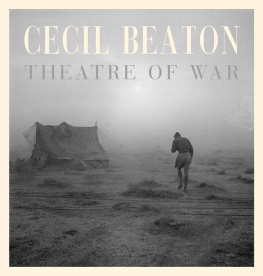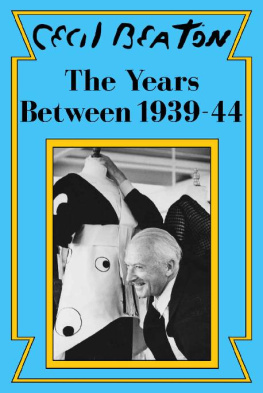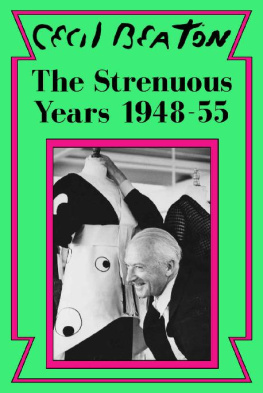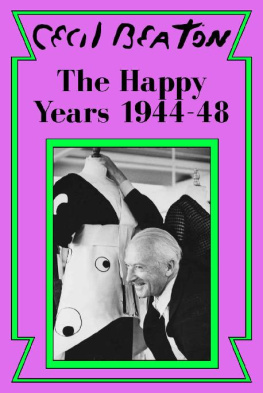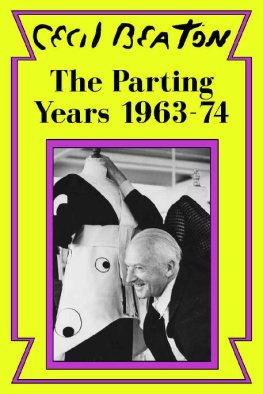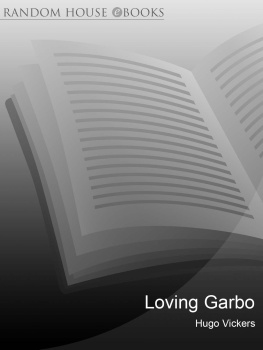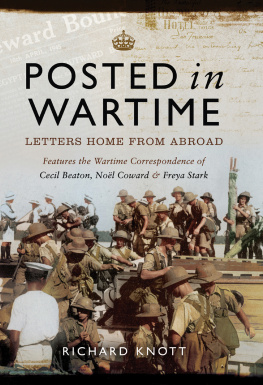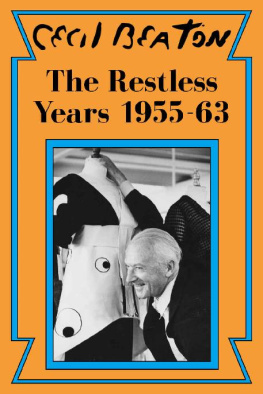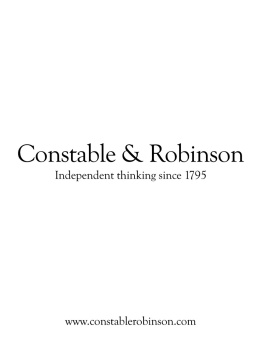Cecil Beaton - Cecil Beaton: Theatre of War
Here you can read online Cecil Beaton - Cecil Beaton: Theatre of War full text of the book (entire story) in english for free. Download pdf and epub, get meaning, cover and reviews about this ebook. year: 2012, publisher: Random House, genre: Non-fiction. Description of the work, (preface) as well as reviews are available. Best literature library LitArk.com created for fans of good reading and offers a wide selection of genres:
Romance novel
Science fiction
Adventure
Detective
Science
History
Home and family
Prose
Art
Politics
Computer
Non-fiction
Religion
Business
Children
Humor
Choose a favorite category and find really read worthwhile books. Enjoy immersion in the world of imagination, feel the emotions of the characters or learn something new for yourself, make an fascinating discovery.
- Book:Cecil Beaton: Theatre of War
- Author:
- Publisher:Random House
- Genre:
- Year:2012
- Rating:4 / 5
- Favourites:Add to favourites
- Your mark:
- 80
- 1
- 2
- 3
- 4
- 5
Cecil Beaton: Theatre of War: summary, description and annotation
We offer to read an annotation, description, summary or preface (depends on what the author of the book "Cecil Beaton: Theatre of War" wrote himself). If you haven't found the necessary information about the book — write in the comments, we will try to find it.
Cecil Beaton: Theatre of War — read online for free the complete book (whole text) full work
Below is the text of the book, divided by pages. System saving the place of the last page read, allows you to conveniently read the book "Cecil Beaton: Theatre of War" online for free, without having to search again every time where you left off. Put a bookmark, and you can go to the page where you finished reading at any time.
Font size:
Interval:
Bookmark:




Sir Cecil Beaton was born in Hampstead in 1904. Throughout his life he was a diarist, painter and interior designer but most recognised as a fashion and portrait photographer for Vogue, Vanity Fair and LIFE. He won several theatre and film awards, including two Academy Awards for his stage and costume design for My Fair Lady, and was knighted in 1972. He died at home in Wiltshire in 1980.
Mark Holborn: Editor
Hilary Roberts: Head of Collections Management, IWM Photograph Archive
Abigail Ratcliffe: Publishing and Licensing Manager, IWM
Design by Jesse Holborn, Design Holborn
Production: Simon Rhodes
Covers and pages of LIFE Magazine, 1 January, 1940 on courtesy of Orion Publishing Group.
All captions have been derived from Cecil Beatons original captions and terminology.
Front cover MH 2718, Boards CBM 2488, Sothebys.
Between 1939 and 1945 Cecil Beaton produced a major body of photographs for the Ministry of Information in London. Imperial War Museums now hold that material, which consists of 7,000 prints and their negatives.
At the time of Beatons official appointment following the outbreak of war, he was a prominent figure with numerous connections in English society and was recognised as a gifted portrait photographer with a great eye for fashion and theatre. He was to become a celebrated costume and set designer for the stage and cinema. In the summer of 1939, on the eve of war, he had been commissioned to photograph Queen Elizabeth at Buckingham Palace. Beaton was to become the greatest of royal portrait photographers and photographed the Coronation of the current Queen in 1953. He regarded himself as a loyal servant of the monarchy and the nation. Despite his glamorous life on both sides of the Atlantic, he always regarded England as his home and the source of his creative nourishment a fact he reiterated throughout his extensive diaries.
Kenneth Clark, the young Director of the National Gallery during the war, was an advisor for the Ministry, and through his offices Beaton was set to work photographing on the home front. He began to record the destruction of the Wren churches in the City for History Under Fire (1941), a book he published with James Pope-Hennessy, and then widened his scope to record the wider devastation of the Blitz, the heroic defence of the city and its citizens under fire. At the invitation of Bomber and Fighter Commands he conducted a photo survey of the RAF, much of which was published at the time with Beatons astute written commentary. He was an effective propagandist, but his voice, like his photographs, was touchingly elegant. Whatever his subject, Beaton was always a stylist.
 Desert Dhobi laundry dries at a British air base, Western Desert, 1942
Desert Dhobi laundry dries at a British air base, Western Desert, 1942 In 1942 Beaton sailed in a convoy for North Africa. After an introduction to the exoticism of Alexandria and Cairo he left for the Western Desert, where he was to produce his most dramatic abstract studies of the detritus of war in a landscape that he described as surreal. Beaton recorded the hardships and physical extremes experienced by the troops, just as he registered the sometimes sublime beauty of desert life. His travels continued that year through Iran, Iraq, Palestine, Transjordan and Syria. Beaton became familiar with the courts of Middle Eastern royalty.
Before leaving for India in 1943, Beaton produced a body of work reflecting the energy of manufacturing and farming at home. The shipyards provided him with a fertile arena of industrial forms and massive geometrical shapes. No subject seemed outside his realm. He was able to realise the visual potential from the most mundane as well as the most dramatic circumstances. When he reached New Delhi, the glories of Lutyens architecture offered him a staggering backdrop against which to record the last years of the Raj. His views of the thrones of Delhi and Calcutta were set against pictures of basic military training or Indian factory production. Outside the cities he revelled in the lush landscape. He came closest to action when he joined the Burma campaign and witnessed the terror and intimacy of jungle warfare against the Japanese.
His final excursion was deep into southern China with the Nationalist forces. Weeks of trekking through jungle gave him vistas of overwhelming beauty coupled with scenes of rural poverty. Even though the views were extraordinary, the experience was so physically taxing that Beaton left China drained and shattered. He headed to New York to recover.
Before the end of the war he enjoyed the hospitality of Diana Cooper at the British Embassy in Paris. He photographed Churchill and de Gaulle at the front as the Germans retreated. In Paris he photographed Picasso, who was an international hero in a liberated city.
 Ruined house, Tobruk, Libya, 1942
Ruined house, Tobruk, Libya, 1942 I had not realised that I had taken so many documentary pictures and that so many were only of technical interest. The amount of work confounded me. I looked at them with the eyes of today, and not those of thirty years ago, and saw many things that today are accepted and that were before their time. It is nice to have so many pictures added to the repertoire of my Best. It was a thrilling but upsetting morning, for I felt that I was dead and that people were talking of me in the past. The greatest collection by one person of any subject in our service. It was also very disturbing to see how many of the people were completely forgotten. But so many too were brought back to life from death.
It is very eerie to discover that, at the age of seventy, I have survived so many younger people. Here were ADCs and husbands of Wavells daughters all long since out of the running. And those that survived are no longer recognisable. It was fascinating to see the scenes in old Imperial Simla, the rickshaws drawn by uniformed servants, the grandeur of the houses, the palaces. It was extraordinary to see the bar scenes, the men on leave, swigging beer, and how I had been able to frat with such unlikely types. It was a morning of deep concentration, and when three hours had passed and I had uncrossed my legs and got up from the dark to prepare myself to go home, it was as if I had been living in a completely different world
I came away pleased that I had done such big jobs (I must go back and see the other half all Egypt and the Middle East and England at war), and marvelled that I had done it with only one Rolleiflex. How it wasnt broken, I do not know; how I had used no shade, or the lens or light meter. Yet it had worked and some of them are, apart from their historic interest, extremely beautiful.
EDITED EXTRACT OF BEATONS ACCOUNT OF A VISIT TO THE IMPERIAL WAR MUSEUM, LONDON, MARCH 13th, 1974
Next pageFont size:
Interval:
Bookmark:
Similar books «Cecil Beaton: Theatre of War»
Look at similar books to Cecil Beaton: Theatre of War. We have selected literature similar in name and meaning in the hope of providing readers with more options to find new, interesting, not yet read works.
Discussion, reviews of the book Cecil Beaton: Theatre of War and just readers' own opinions. Leave your comments, write what you think about the work, its meaning or the main characters. Specify what exactly you liked and what you didn't like, and why you think so.

